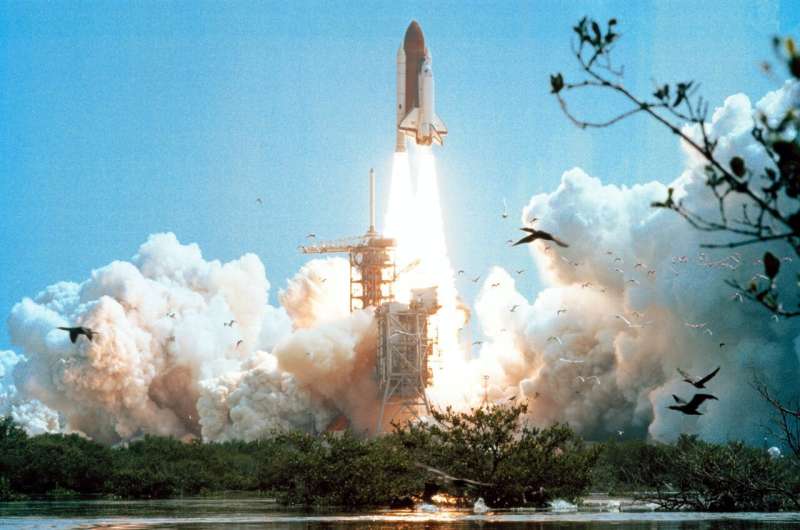This article has been reviewed according to Science X's editorial process and policies. Editors have highlighted the following attributes while ensuring the content's credibility:
fact-checked
peer-reviewed publication
trusted source
proofread
Researchers explore how the immune system goes awry during space travel and the implications for human aging on Earth

As long as humans have been traveling into space, astronauts have experienced significant health effects from the extreme conditions of space flight, notably the reduction of gravity.
Two Buck scientists led a team that has revealed for the first time how the lack of gravity affects the cells of the immune system at single cell resolution. The co-senior authors, along with Christopher E. Mason, Ph.D. of Weill Cornell Medical College, Associate Professor David Furman, Ph.D. and Associate Professor Daniel Winer, MD, have published an extensive survey of how gravity affects immune cells, and the identification of "space nutraceuticals" to counter aberrant effects of microgravity on these cells. The work is published in Nature Communications
"We show how simulated microgravity shapes immune cells and how the changes in force alter the cells' function at the single cell level," said Winer. "This level of resolution is new and exciting in understanding the effects of microgravity on cells."
Using cells in simulated microgravity, combined with data from space flight from astronauts and mice on the International Space Station, the researchers created a complete picture of how the different cells of the immune system in the peripheral blood are shaped by reduced gravity. These cells include lymphocytes and monocytes, which are the main players in immunity.
The study has potential implications for immune aging on Earth since the changes observed during aging resemble those captured during space travel.
The team additionally outlines a pathway for identifying compounds that can reverse the effects of near zero gravity, and demonstrates that one of the compounds, quercetin, shows promise for mitigating the damage caused by spaceflight and during normal aging on the ground.
"Our work provides a resource to better understand how and why the immune system changes in simulated microgravity and spaceflight," said Furman. "We also provide a way to develop countermeasures to maintain normal immunity under these harsh conditions."
Astronauts in low Earth orbit, such as on the International Space Station, suffer from immune system problems, especially infections, latent viruses reactivating, and skin sensitivity. These reactions occur even on short-term spaceflights.
Previous studies using actual or simulated microgravity conditions have found impaired function of various immune cells. However, the fundamental mechanisms, genes, and pathways that explain immune dysfunction in microgravity were mostly unclear, the researchers said. They wanted to understand what was happening on a cellular level to explain the changes.
The team, led by the study's co-first authors Buck postdoctoral researcher Fei Wu, Ph.D. and graduate student Huixun Du, examined in depth how 25 hours of simulated microgravity affects the human peripheral blood mononuclear immune system, using samples from 27 healthy human donors between the ages of 20 and 46.
To simulate an environment with almost no gravity, the team grew the cells inside of a Rotating Wall Vessel, a device developed by NASA to simulate microgravity conditions.
To explore the changes caused by reduced gravity, the team used a number of techniques, including sequencing and super-resolution microscopy.
They then validated their findings by comparing their data with other space studies done in humans and mice, including the JAXA (Cell-Free Epigenome study) mission, SpaceX's Inspiration 4 mission, NASA's Twins Study, and spleens from mice housed on the International Space Station.
"Interestingly, changes in mechanical forces appear to orchestrate immune cell function," said Winer, whose interest in studying space medicine grew from him delving into the emerging field of mechanoimmunology, or how environmental forces affect immune cell function. Parts of astroimmunology are related to mechanoimmunology, but it is proving its own as a new field, he said, paving the way to better understand how to help the immune system survive in space.
After unearthing several genes and biochemical pathways that are affected by microgravity, the team wanted to see if they could find any specific drugs or supplements that could protect the immune cells. To help them search, they used machine learning technology developed by Furman at the Buck, which can detect more than 2 million interactions between genes and different drugs and foods.
They identified dozens of potential compounds and chose one, the plant pigment quercetin (often found in red onions, grapes, berries, apples and citrus fruits among others) to explore further since it is widely available as an antioxidant and anti-aging supplement. Quercetin turned out to reverse approximately 70 percent of the changes caused by lack of gravity and protected the cells from reactive oxygen species excess.
"These findings define hallmarks of immune cell alteration in simulated microgravity, with correlation to spaceflight exposures in mice and humans," said Winer.
"This work helps define avenues for future research in mechanoimmunology and astroimmunology and provides opportunities to develop countermeasures to maintain normal cellular function in space."
Furman adds that this publication sets the standard for how to analyze the physiological changes that accompany space travel. "This is the first comprehensive study that provides the scientific community worldwide with an atlas to understand human biology in this extreme condition," he says.
"The implications are huge, beyond humans in space," he adds. The researchers are excited to explore the parallel changes they are finding that occur in aging humans on the ground, and to use the knowledge to design interventions that can potentially reverse the immune dysfunction that accompanies aging.
More information: Single Cell Analysis Identifies Conserved Features of Immune Dysfunction in Simulated Microgravity and Spaceflight, Nature Communications (2024). DOI: 10.1038/s41467-023-42013-y
Journal information: Nature Communications
Provided by Buck Institute for Research on Aging





















